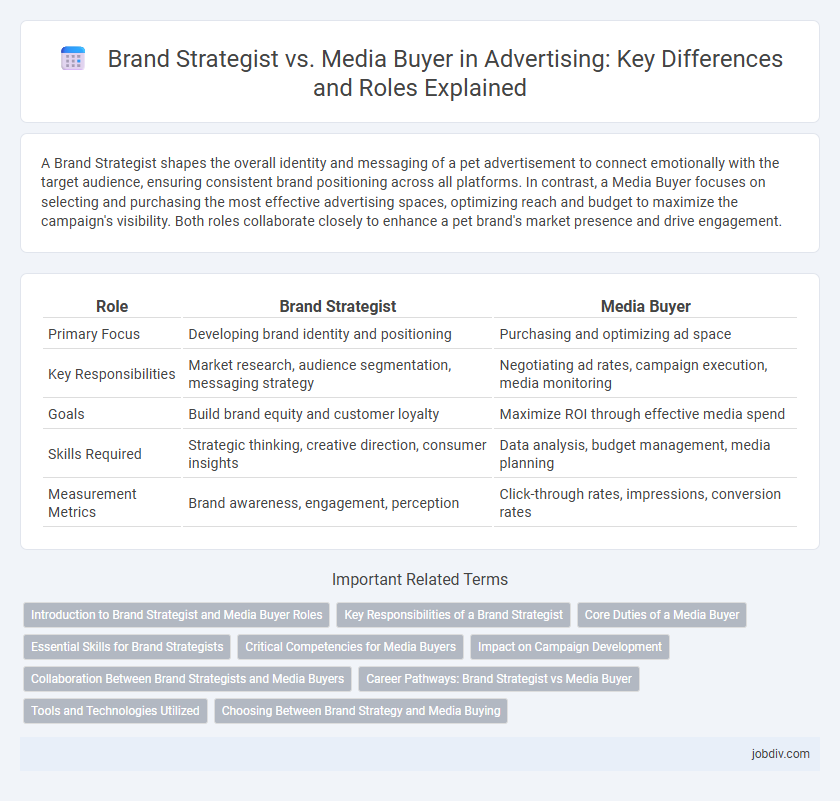A Brand Strategist shapes the overall identity and messaging of a pet advertisement to connect emotionally with the target audience, ensuring consistent brand positioning across all platforms. In contrast, a Media Buyer focuses on selecting and purchasing the most effective advertising spaces, optimizing reach and budget to maximize the campaign's visibility. Both roles collaborate closely to enhance a pet brand's market presence and drive engagement.
Table of Comparison
| Role | Brand Strategist | Media Buyer |
|---|---|---|
| Primary Focus | Developing brand identity and positioning | Purchasing and optimizing ad space |
| Key Responsibilities | Market research, audience segmentation, messaging strategy | Negotiating ad rates, campaign execution, media monitoring |
| Goals | Build brand equity and customer loyalty | Maximize ROI through effective media spend |
| Skills Required | Strategic thinking, creative direction, consumer insights | Data analysis, budget management, media planning |
| Measurement Metrics | Brand awareness, engagement, perception | Click-through rates, impressions, conversion rates |
Introduction to Brand Strategist and Media Buyer Roles
A Brand Strategist focuses on developing a cohesive brand identity and positioning by analyzing market trends, consumer behavior, and competitive landscapes to create long-term growth strategies. A Media Buyer specializes in planning, negotiating, and purchasing advertising space across various platforms such as digital, TV, and print to maximize campaign reach and effectiveness. Both roles collaborate closely to ensure brand messaging aligns with targeted media placements for optimal consumer engagement.
Key Responsibilities of a Brand Strategist
A Brand Strategist develops comprehensive brand plans by analyzing market trends, defining target audiences, and crafting unique brand messaging to establish a strong market position. They focus on building brand identity, ensuring consistency across all channels, and driving long-term customer loyalty through strategic storytelling and value propositions. Unlike Media Buyers, Brand Strategists do not handle ad placements but concentrate on shaping the brand's overall perception and guiding creative direction.
Core Duties of a Media Buyer
A Media Buyer is responsible for purchasing advertising space across various platforms to maximize campaign reach and ROI, leveraging data analytics to target the right audience effectively. They negotiate rates, analyze market trends, and optimize media plans to ensure efficient budget allocation and high conversion rates. Unlike Brand Strategists who focus on overarching brand messaging and positioning, Media Buyers concentrate on tactical execution and real-time media performance.
Essential Skills for Brand Strategists
Brand strategists excel in market research, consumer behavior analysis, and crafting compelling brand narratives that align with business goals. Their essential skills include strategic thinking, creativity, and proficiency in communication to ensure consistent brand messaging across all channels. Unlike media buyers who focus on ad placements and budget optimization, brand strategists prioritize long-term brand equity and customer loyalty development.
Critical Competencies for Media Buyers
Media buyers excel in data analysis, targeting precision, and negotiation skills to secure optimal ad placements within budget constraints. They demonstrate proficiency in media planning tools, audience segmentation, and performance optimization to maximize return on investment (ROI). Strong communication and relationship management abilities enable media buyers to collaborate effectively with publishers and ensure campaign success.
Impact on Campaign Development
Brand strategists shape the overall vision and messaging of advertising campaigns by aligning brand identity with target audience insights, creating a cohesive narrative that drives long-term engagement. Media buyers execute these strategies by selecting optimal channels and negotiating ad placements to maximize reach and cost efficiency, directly influencing campaign performance metrics such as impressions and conversion rates. Their combined efforts ensure campaigns are both conceptually strong and tactically effective, boosting brand awareness and return on investment.
Collaboration Between Brand Strategists and Media Buyers
Brand strategists develop comprehensive brand messaging and positioning that guide campaign objectives, while media buyers execute targeted ad placements to maximize reach and engagement. Effective collaboration ensures alignment between creative direction and media strategy, optimizing budget allocation and audience targeting. This partnership enhances campaign performance by seamlessly integrating brand identity with data-driven media planning.
Career Pathways: Brand Strategist vs Media Buyer
Brand Strategists focus on crafting long-term brand positioning and message consistency, requiring skills in market research, consumer psychology, and creative direction, which often lead to roles in marketing management or chief branding officer positions. Media Buyers specialize in analyzing audience data and negotiating advertising space across platforms, developing expertise in media planning and digital analytics, with career progression towards media director or digital marketing manager roles. Both pathways demand strategic thinking and data literacy but diverge in focus--brand strategists shape the brand's identity, while media buyers optimize the delivery of advertising campaigns.
Tools and Technologies Utilized
Brand strategists primarily utilize market research software, consumer analytics platforms, and branding tools like SEMrush and HubSpot to craft compelling brand identities and messaging. Media buyers rely heavily on programmatic advertising platforms, demand-side platforms (DSPs) such as The Trade Desk, and data management platforms (DMPs) to optimize ad placements and maximize ROI. Both roles integrate CRM systems and digital analytics tools like Google Analytics to measure and refine campaign effectiveness.
Choosing Between Brand Strategy and Media Buying
Choosing between a brand strategist and a media buyer depends on campaign goals: brand strategists prioritize building long-term brand identity and market positioning, while media buyers focus on optimizing ad placements and budget for immediate reach and conversion. Brands seeking to establish a clear value proposition and audience segmentation benefit from brand strategy, whereas campaigns aiming for targeted ad delivery and performance metrics require expert media buying. Understanding these roles ensures effective allocation of resources and maximizes advertising ROI.
Brand Strategist vs Media Buyer Infographic

 jobdiv.com
jobdiv.com